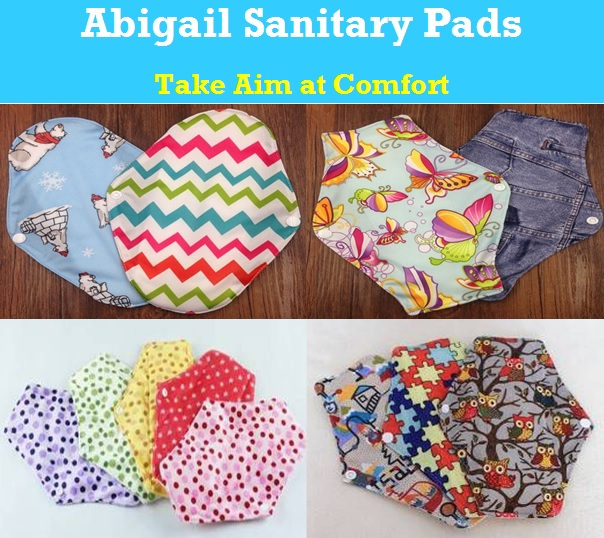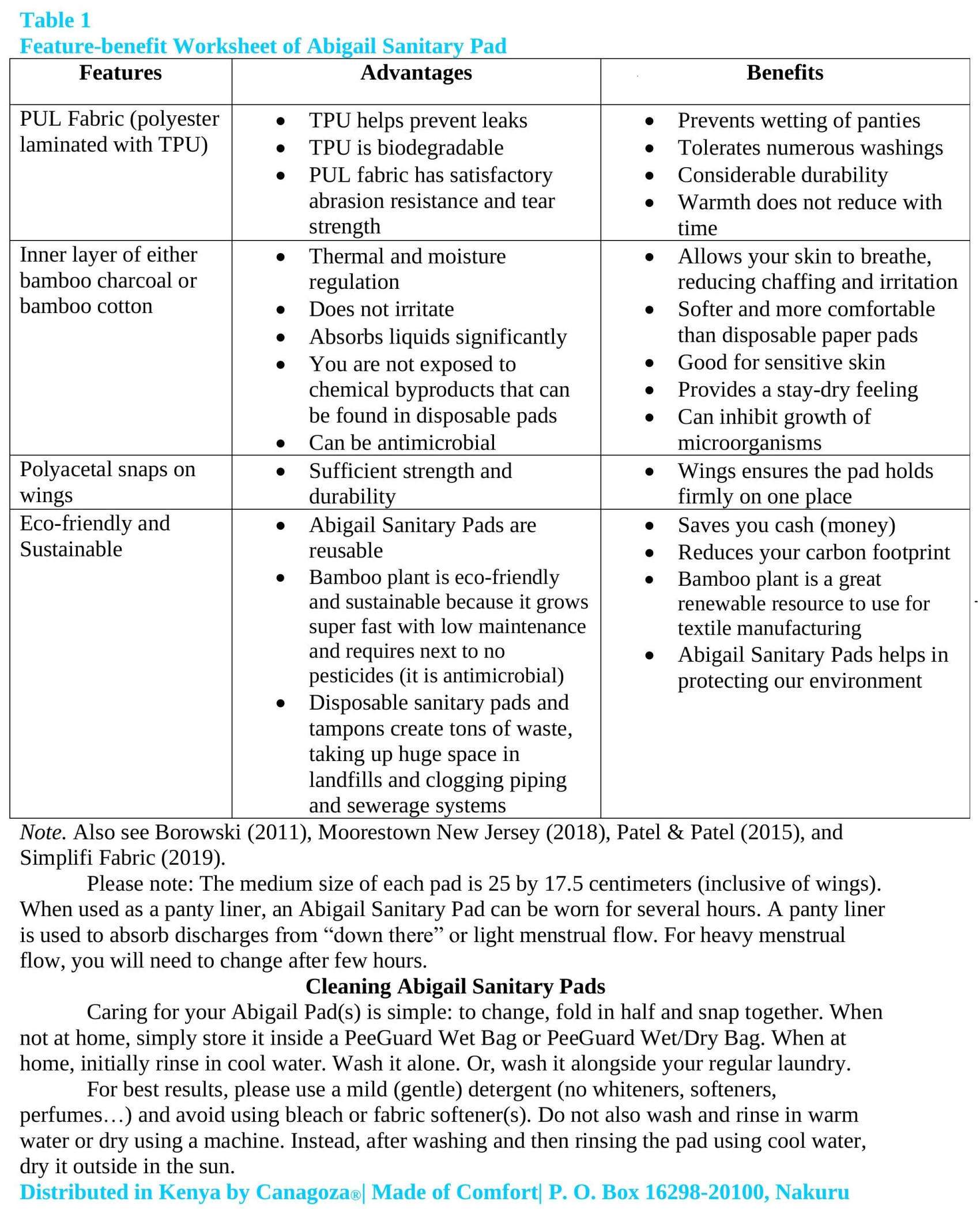


Cloth Sanitary Pads: Key Facts
It is time you gave yourself a little bit of luxury. Abigail Sanitary Pad from Canagoza is a modern-day cloth sanitary pad that is very simple to use. It provides an effective alternative to disposable pads.
Washable and reusable, Abigail Sanitary Pad is much more comfortable than a disposable pad. Thanks to advances in textiles, it is now possible to have the benefits of reusable products with the ease of disposables.
Abigail Sanitary Pad features an inner layer of either bamboo charcoal or bamboo cotton fabric, which provides a stay-dry feeling.
Absorbent middle fabrics include microfiber.
A hidden waterproof layer helps prevent any leaks through onto your underwear. Actually, the layer is polyurethane laminate (PUL) fabric.
PUL comes either in solid color or printed. It is also available as either minky solid or minky printed.
Each Abigail Sanitary Pad has polyacetal snaps to hold it securely to a panty, rather than the adhesive strip/tape on the disposable pad.
Please note that the medium size of each pad is 25 by 17.5 centimeters (inclusive of wings).
Discussing bamboo fabric in detail, bamboo fabric is super soft, hypoallergenic on sensitive skin, very absorbent, and can have textile antimicrobial capability. Bamboo sanitary pads are good for sensitive skin, as bamboo fabric can be antibacterial and antifungal (Bimbi, 2015; Xi et al., 2013).
Unlike cotton, the bamboo fiber can have an antimicrobial biological agent called bamboo kun, which can protect from nasty bacteria, fungi (mold and mildew), and unpleasant odors without the use of harmful chemicals.
Bamboo absorbs and wicks water better than cotton. It is because bamboo fiber is filled with multiple micro-holes and micro-gaps (Bimbi, 2015; Xi et al., 2013).
Why Choose Abigail Sanitary Pads?
Naturally best and Healthy: Stops Exposure to Chemical Byproducts
The issue of safe sanitary protection is of key importance, and it is an issue affecting girls and women throughout the world. With huge increases in cancer and other diseases, we need to be sure of what we are putting in and on our bodies (Borowski, 2011).
Abigail Sanitary Pads do not contain the bleaches, perfumes, or other harsh chemicals used in making most disposable sanitary towels and tampons (Borowski, 2011).
In Kenya, girls and women who used disposable pads complained about “rashes, weird overly perfumed odours, and general irritation” (Arunga, 2020).
Disposable feminine hygiene manufacturers often bleach their raw materials (used in making disposable feminine hygiene products) to make them appear whiter. The bleaching process has been found to leave behind residues of dioxins, chemicals that are both very toxic and carcinogenic (Borowski, 2011).
Disposable feminine hygiene products have been blamed for many girls' and women’s health issues due to the creation of the dioxins. Such health issues include causing cancer, toxic shock syndrome, and other bacterial infections (Borowski, 2011).
Reputable brand name disposable pads contain almost four plastic bags in their makeup. Plastic does not allow sufficient airflow “down there,” so in turn can also cause an array of infections. Plastic contains Bisphenol A (BPA), which is linked to heart disease and cancer (Healthy Food Star, 2015).
In stark contrast, for Hopkins (2018) of University of Missouri-Kansas City, reusable menstrual pads can reduce infections and skin rashes, because they are more breathable than disposable pads that have plastic lining.
Abigail washable pads feel luxurious to the skin. The pads are the ideal choice for protecting sensitive skin.
Saves Money
The average North American woman throws away 16,800 disposable pads and tampons in her lifetime (Eco Femme, 2015). Amazing how much it adds up.
Abigail Cloth Sanitary Pads may involve a higher upfront cost than the disposable alternatives, but with each pad lasting hundreds of wears, the long-term savings are clear.
Eco-friendly
Using Abigail Cloth Pads can reduce your carbon footprint by up to 40%. Cumulatively, they use less water and energy to produce. The pads do not contribute to landfill like disposables (Borowski, 2011).
In that light, disposable pads and tampons are not only harming your health, but also the Earth. The plastics disposable pads are made out of cannot be easily disposed and degrade. They thus end up sitting in a landfill for hundreds of years, where their toxic chemicals leak into our environment (Borowski, 2011).
Surprisingly, a disposable pad is estimated to take between 500 to 800 years to decompose (Peberdy et al., 2019).
Dioxins, produced during the manufacturing of disposable sanitary towels, bioaccumulates in the environment. Environmentalists have been fighting to keep dioxins out of waterways for years (Borowski, 2011).
According to the results of a survey by Borowisk (2011) of Rochester Institute of Technology in New York, United States, American women would prefer more natural menstrual products.
American women are also most concerned about the prices of disposable menstrual products and the environmental impact of these products (Borowski, 2011).
Disposable sanitary pads and tampons create tons of waste, taking up space in landfills and clogging piping and sewerage systems, and overflowing onto beaches in coastal regions (Borowisk, 2011; Moorestown New Jersey, 2018).
In India, most disposable pads end up littering village roadsides or getting burned in huge trash heaps, releasing toxins from the plastics (Eco Femme, 2015).
Easy to Use
Shaped like disposable sanitary pads and made with absorbent fabrics, Abigail Cloth Pads are absorbent, effective, and can be just as simple to use as the disposable alternatives.
The fabrics used to manufacture the pads mean cleaning is a simple, worry-free task.
Incorrect Convenience
You may think disposable sanitary pads are more convenient than regular cloth sanitary pads, but the convenience of disposable sanitary pads is largely an illusion. Consider the extra hours you or your parent(s) may have to work to cover the cost of disposable sanitary pads.
Cloth sanitary pads are also not terribly inconvenient to wash: they come clean after just one cool-water load and can be washed alongside your regular laundry.
Cleaning Abigail Sanitary Pads
Caring for your Abigail Pad(s) is simple: to change, fold in half and snap together.
When not at home, simply store it inside a PeeGuard Wet Bag or PeeGuard Wet/Dry Bag. When at home, initially rinse in cool water.
Wash it alone. Or, wash it alongside your regular laundry.
For best results, please use a mild (gentle) detergent (no whiteners, softeners, perfumes…) and avoid using bleach or fabric softener(s).
Do not also wash and rinse in warm water or dry using a machine. Instead, after washing and then rinsing the pad using cool water, dry it outside in the sun.
Optionally, you can add one of the following to the soaking water: a dash of lemon juice, a dash of white or apple cider vinegar, 2-3 drops of lavender, or 2-3 drops of tea-tree/eucalyptus oil.
All of those are gentle and effective antibacterial (antimicrobial).
The sun is also effective at killing germs. Hang your pads out in the sunlight for the day if you are worried about germs.
Notably, the PeeGuard Wet/Dry Bag from Canagoza allows you to carry your soiled and clean Abigail Sanitary Pad/s in the same bag, as it has both wet and dry sections.
In comparison, the PeeGuard Wet Bag allows you to only carry your soiled Abigail Sanitary Pad/s, as it has only a wet section.
How is the heaviness of Menstrual Flow classified?
When used as a panty liner, an Abigail Sanitary Pad can be worn for several hours, perhaps up to 12 hours.
A panty liner is used to absorb discharges from “down there” or light menstrual flow.
For heavy menstrual flow, you will need to change after few hours, perhaps after every 1-2 hours.
In fact, in case you were performing scientific research, you would need to measure your monthly menstrual flow in milliliters, which is not an easy task.
The simplest way is to count the number of sanitary pads you use and how frequently you change them:
(i) Minimal: Spotting or simply a few drops
(ii) Mild: Less than one saturated pad in three or more hours
(iii) Moderate: More than one saturated pad in under three hours
(iv) Heavy: More than one or two saturated pads in one or two hours; this rhythm is common for some women, but uncommon.
At times, heavy periods are caused by subtle health problems. They can lead to other health issues.
If your flow is long-term and heavy (say, more than six pads daily), and that is not typical for you, you should consult a doctor. She may be able to help (Chartier, 2016; WebMD, 2020).
Notably, Abigail Reusable Postpartum Sanitary Pads are used to absorb heavy flow of blood after giving birth. After childbirth, a mother may experience postpartum bleeding for a period of up to six weeks. Postpartum pads are also essential before childbirth. Some expectant women use the pads while travelling to hospital. Or, the expectant women use the pads to prevent leaks after they have broken their water (WebMD, 2021).
Exposing Myths about Reusable Cloth Sanitary Pads
(1) Everyone complained using cloth pads was unhygienic because they were made to dry in a damp place (Lyer, 2014).
Cloth pads need to be dried in sunlight or in well-ventilated areas.
(2) Cloth pads felt heavy -- they feel clunky and often did not fit well.
The way they are designed makes all the difference. Modern-day cloth sanitary pads come with wings, which place them firmly in one place and this is why they are convenient (Lyer, 2014).
Cloth is softer than disposable paper sanitary pads -- that is the end of the story. Otherwise, wouldn't we all be wearing paper underwear?
Wayne (2012), a British woman, writes:
Cloth pads are comfortable! I can’t emphasize that enough. At first, I thought they felt bulkier than the disposables I was used to, but soon (within minutes), they just felt like underwear. The cloth moves with your body and is silent, unlike the crinkly paper and plastic of disposables. The cloth is also more breathable and less odorous, I find.
(3) We have to wash them and who has that kind of time anyway?
Contrary to popular believes, washing a cloth pad is not so time consuming. Soaking before washing only takes less than five (5) minutes (Lyer, 2014).
Wayne (2012) further writes:
Care for [cloth] pads is so much easier than I had feared. I just rinse or soak them in cold water to help with staining (this is optional), then toss them into either a cloth diaper wash or a regular wash. (I’ve had no problems either way.) They can usually be line dried.
(4) Polyurethane Laminate (PUL) Fabric Causes Irritations and Skin Rashes
In a cloth pad made of PUL as the waterproof (spillproof) material, the PUL layer is on the bottom. There is an inner bamboo charcoal or bamboo cotton layer that touches your skin and two middle layers of microfiber fabric.
Bamboo charcoal/bamboo cotton does not cause irritations and skin rashes. Both bamboo charcoal/bamboo cotton and microfiber are breathable (Patel & Patel, 2015).
Kenya Standard (KS 2925:2020) from the Kenya Bureau of Standards requires all reusable sanitary pads to be spillproof (no leakage) and not create chaffing. The reusable pads should be comfortable to wear, have good fit, and remain in place.
The pads should also not cause odor, noise, and humidity; be typified by high level of hygiene; and should be simple to use (KEBS, 2021).
References
Please click on (or tap on) the following link to access/view the "References": References -- Abigail Sanitary Pads.doc